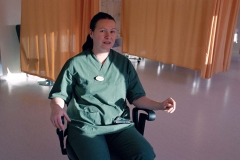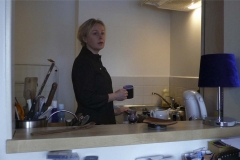I recently saw Alexei Yurchak’s book on your table, Everything was forever, until it was no more: The last Soviet generation…
The concept of ‘the last Soviet generation’ was used by Elo-Hanna Seljamaa when she described how I actually fit in in her article for the Venice project catalogue A Woman Takes Little Space.
How did you develop into an artist?
I think I will keep developing indefinitely. I certainly do not feel as if I have fully developed.
Has this generational definition determined something in particular?
It is difficult for me to say. My generation is usually described as nihilistic, a group who do not believe in anything, as we were used to hearing one thing at home and another officially. Double morals, hypocrisy, double standards, all lead to people believing noth-
ing, being emphatically apolitical, refusing to participate in elections etc.
This surely does not relate to your work.
It did. A great deal. At the beginning, twenty years ago.
What happened then?
Maybe I was beginning to feel trust in the Estonian society. Or not even ‘trust’, but responsibility. An understanding of myself and my responsibility to society. I would not want to stress Estonia in this context.
Your connection with ‘Estonia’ is not important to you?
Of course it is, but it is now somehow more normal and calmer. Since I am living here, I am here. Being away for a while and coming back, I can now look at things from a distance much better. Translate them any which way.
You have not thought of moving somewhere else?
There have been all sorts of thoughts. It was very interesting to live in Estonia in the 1990s, but now the situation is getting a bit weird; turning more inside than outside, a kind of provincialization is taking place. The surrounding world is becoming increasingly conservative, self-sufficient, and this is bor- ing and tedious. Bad times for culture and especially bad times for contemporary art. We in Estonia are perhaps still less conventional than elsewhere – at least as far as working is concerned. It is much easier to work here than somewhere else.
In what sense?
It is still possible here to have access to people and places.
How do people react to your ideas?
Differently.
For example, when I want to photograph women at their workplaces, they often ask: “Why me? I am not young or pretty.” But this is not the aim of my work. I take photographs of people in their jobs and living situations. Many are dissatisfied with how they look or where they work. When I once wanted to take a picture of a woman in her restricted working place, she asked: “Is this a feminist project?” I
explained that, although the project A Woman Takes Little Space deals with women’s topics, I do not regard it as directly feminist. However, she did not want to show herself in that con- text. Quite understandable.
You have never been too keen on feminist art yourself, have you?
I am always keen on work that is inter- esting, although all definitions are indeed discriminating. I think feminists would prefer politically active standpoints. In that respect, my work does not qualify. It instead allows ambivalent understanding.
Is this a conscious aim or has it just developed so?
It is perhaps my nature not to hurl myself onto the barricades, but to stand by observing.
Why these women in particular?
What I am actually doing is dealing with myself through these women. When, for example, I take pictures of a woman with the Russian-speaking background, I try to put myself in her shoes or ask myself what I am feeling and thinking? How am I behaving at the moment? I try to understand what the ‘endless horror’ means when you go to work in the morning and carry on for 12 hours on your feet. I have never had to work like that. I will never understand them fully. Of course, I sometimes work at my art for 24 hours run- ning, but mostly on my own and sitting.
What do you feel?
Total sympathy towards these people.
How do you choose people?
If I see somebody who seems interesting and catches my eye for some reason, that is all I need. I then ask permission to take pictures. This does not mean that the photographs will be good. As Alfred Hitchcock taught: what matters in the end is what is in the shot.
Are there many failures?
I work uneconomically: I use film (because it produces better quality than a digital cam- era), two or three rolls of film for each person, so on the average 72 shots, and then I choose only one, and sometimes I do not choose any.
How much do you stage your shots?
Recently I have been trying not to stage anything at all. I want the person to continue working when I am there with my camera. Forget about me. In other situations, life itself is the best stage manager. You just have to wait.
For some reason this makes me think of Nan Goldin...
I have been thinking about her too. In 2002 I saw her big exhibition in Whitechapel Gallery in London. My fellow students talked about it with great enthusiasm, but I did not take to it then: it was a bit pathetic and exhi- bitionistic. However, I think I am beginning to understand her now. Her relationship with life and death.
You are interested in ordinary people, not extravagance?
That’s true. This may perhaps be an East- European topic.
Why East-European?
Because we still have in our blood the earlier rhetoric in which the ‘ordinary per- son’ was constantly displayed and heroised for ideological reasons. It was necessary for some people, à la series such as Woman on a Combine, Woman with Cattle etc. I am interested in the working woman, the conditions in which a working woman has been placed. The environment where she works is not exactly extravagant, but the mise-en-scène cannot leave the viewer visually indifferent. Sometimes you have no choice but to photo- graph them. The ordinary working woman is hardly ever shown in the media, except for some scandal. I want to make such women more visible.
Have you thought about experimenting, e.g exchanging places with your models?
I have indeed. And soon I probably will.
Is the concept of ‘humiliation’ also significant?
I would not call it humiliation, but meek- ness. These women fascinate me because they do not hate their jobs. There is no passion; they simply have no other choice, but they do their work with dignity – so that they still respect themselves. They still have a sense of humour; they stay in touch and look after one another.
Your photographs do not display a critical attitude.
As one of my favourites, Virginia Woolf, wrote in her essay A Room of One’s Own: when a woman starts writing something, she must not be angry, because anger often intrudes into writing. You really must have something to tell people, and not just be angry. This is what I am trying to achieve, although I occasionally feel that anger gets the better of me.
Besides, artists cannot make overly large generalisations with their works. Sociologists often precisely describe some phenomenon, for instance the bad aspects of living in a new residential district. However, when you talk with people, it appears that this is not neces- sarily true at all.
Is it pure chance that your ‘models’ are mainly Russian-speaking women?
There are a few Estonians as well. I do not select my ‘actors’ according to their national- ity, but according to what they denote. My aim is to reach the point where we communicate as one human being with another. Whether someone is Russian and I am Estonian no longer really matters. I can photograph those people who agree to be photographed.
































